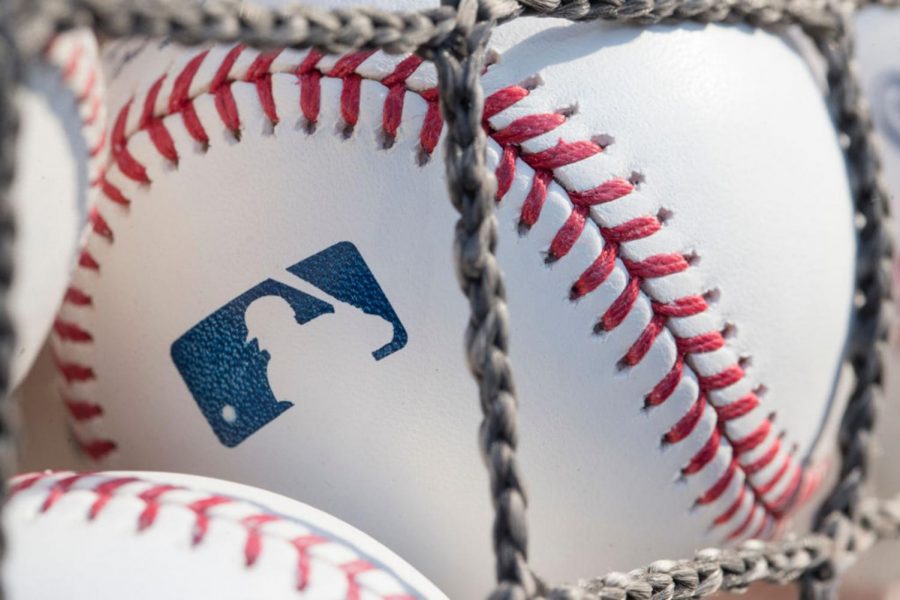Two Division 1 universities cut baseball programs
Photo Courtesy of Mitchell Leff / Getty Images / TNS
A baseball with the MLB logo sits at Citizens Bank Park before a game between the Washington Nationals and Philadelphia Phillies on June 28, 2018 in Philadelphia, Pennsylvania.
June 3, 2020
Bob Moosbrugger, the athletic director of Bowling Green State University, announced that his athletic department will be eliminating the school’s baseball program in wake of heavy financial losses from the COVID-19 pandemic. The same decision was made by Furman University, who announced that in addition to baseball, the men’s lacrosse team will also cease operations on the South Carolina campus.
The unfortunate fate of Furman’s baseball team concludes a near 130-year history dating back to 1891. During that time, the team made five NCAA tournament appearances, most recently in 2005 where they were eliminated in the first round by Michigan. Furman enrolls 2,700 students, making it one of the smallest institutions to compete in Division-1 athletics and the only liberal arts college that Sports illustrated listed on their top 100 Sports Colleges list. Despite its selective enrollment, Furman has 32 alumni competing at the professional level, the most of any Southern Conference school. Among Furman’s alum is Jay Jackson, a former MLB pitcher currently signed to the Chiba Lotte Marines in Japan’s Pacific League.
In an attempt to save more money, Furman’s head coaches and athletic director will be taking 10% pay cuts as athletic scholarships will be slashed by 45.
The Bowling Green Falcons leave behind a similar legacy, with four NCAA Tournament appearances as a member of the Mid-American Conference. The Ohio school spawned several prominent Major Leaguers including Orel Hersheiser who was a 3-time All-Star and a Cy Young Award winner. Moosbrugger was also part of Bowling Green’s program in the nineties and was coached by Dany Schmitz, the acting head coach when the program was terminated on May 15, ending his 30-year tenure.
It is unlikely that these will be the only programs in jeopardy as Illinois head coach Dan Hartleb expects there will be more tough financial decisions made by schools in the near future.
Get The Daily Illini in your inbox!
“I think there are a lot of schools that are going to evaluate all of their finances,” Hartleb said. “With some of the Title IX legislation, some of the men’s programs would be ones that could be eliminated before some others. I think as a whole college athletics is going to be paired down. I think there will be a few more baseball programs in the mix.”
The head coaches of several college baseball programs have been meeting weekly to reevaluate NCAA baseball as a whole in an effort to save money in the future. The proposal they have come up with includes tweaking several seemingly outdated traditions that could be adopted as soon as 2022.
The adjustments include:
-Moving opening day back four weeks
-Expanding the preseason
-Shortened fall ball
-Moving fall scrimmages to the spring
Pushing back opening day would reduce the need for northern schools to travel south. Opening day is typically scheduled in the middle of February when it is too cold to play games at their respective home fields. According to the proposal, a competitive northern team in the Big Ten Conference spent an average of $233,728 on travel in the last five years during the first month of the season.
While travel costs are high the way things stand now, mid-February is also when college basketball is ramping up for the NCAA tournament. Opening day for College baseball easily gets overshadowed by the hype leading up to March Madness.
“I think it’s a great proposal and it would be good for college baseball as a whole,” Hartleb continued. “It would be really good for us to save some money upfront from a travel standpoint. I think we can create some revenue on the backside with a lot more home games. There’s a number of areas that I think, if you look at student athlete welfare, you look at academics and then you look at finances, it’s a win in every category.”
The proposal also aims to reduce Fall baseball. Coach Hartleb would like to take advantage of this change and give his players an entire month off to get their bodies and minds off the game. Then return to baseball after winter break, which would give him around seven weeks to prepare his athletes for the season.
“The beauty of that then is the fact that we would have seven to seven and a half weeks to get our guys ready when they come back after the holiday break,” Hartleb explains. “And to me that’s very important just because we’re with them, we know exactly what they’re doing and we know how they’ve prepared. It gives us time to bring the pitchers along. Also, it keeps them out of the colder weather as far as having to throw in that type of situation.
The next thing on the agenda for college baseball is the first year player draft, which will be televised on ESPN2 and the MLB network on June 10th and 11th. The normal 40 round draft has been significantly reduced to save money after revenue loss from no season. The Detroit Tigers will have the first pick. Stay tuned for updates on Illinois seniors following the draft.
@ebs_rich







